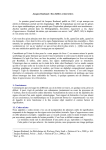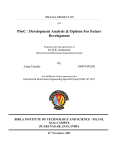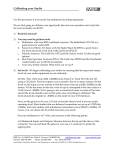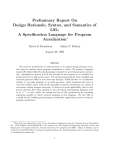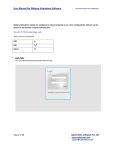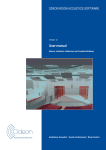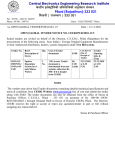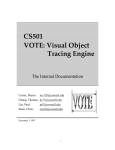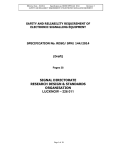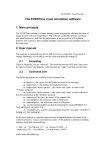Download JLISTEN PROTOTYPE USER MANUAL
Transcript
JLISTEN
PROTOTYPE USER MANUAL
Team Members
Vijaya Ganesh.V [Team leader]
Jagadish Prasath R
Pradap K V
Mudit Mathur
Gopinath M C
Nageswar Rao Katta
B.I.T.S Pilani, India
Client
Prof. Aditya P Mathur.
Purdue University. USA
TABLE OF CONTENTS
Overview:------------------------------------------------------------------------------------------------------------ 2
Architecture: -------------------------------------------------------------------------------------------------------- 2
Auraliser:---------------------------------------------------------------------------------------------------------------2
Configuration Server: ------------------------------------------------------------------------------------------------2
Listener -----------------------------------------------------------------------------------------------------------------3
JListen Toolkit:----------------------------------------------------------------------------------------------------- 4
Auraliser:---------------------------------------------------------------------------------------------------------------4
LSL Editor: ---------------------------------------------------------------------------------------------------------4
Instrumentor:---------------------------------------------------------------------------------------------------------6
Registration of Program: ------------------------------------------------------------------------------------------7
Configuration Server: ------------------------------------------------------------------------------------------------8
Configuration Server - Network Info --------------------------------------------------------------------------9
Listener: -------------------------------------------------------------------------------------------------------------- 10
Program Registration:------------------------------------------------------------------------------------------- 11
Event- Sound Mapping: ---------------------------------------------------------------------------------------- 12
Recorder: ------------------------------------------------------------------------------------------------------------ 13
Deployment information:----------------------------------------------------------------------------------------14
Software Requirements: ------------------------------------------------------------------------------------------- 14
Source File Structure: ---------------------------------------------------------------------------------------------- 14
Batch Files: ---------------------------------------------------------------------------------------------------------- 14
INSTRUMENTOR---------------------------------------------------------------------------------------------- 14
CONFIGURATION SERVER -------------------------------------------------------------------------------- 15
LISTENER ------------------------------------------------------------------------------------------------------- 15
EXECUTION PLATFORM: ---------------------------------------------------------------------------------- 15
Order of invocation:------------------------------------------------------------------------------------------------ 16
Auralisation Of Sample Programs-----------------------------------------------------------------------------17
Program 1: -------------------------------------------------------------------------------------------------------- 17
Auralization Procedure: ---------------------------------------------------------------------------------------- 18
Program 2: -------------------------------------------------------------------------------------------------------- 19
Auralisation Parameters: --------------------------------------------------------------------------------------- 19
J-Listen
1
TABLE OF CONTENTS
FIG 1: INSTRUMENTOR – SELECT JAVA PROGRAM ------------------------------------------------------4
FIG 2: LSL EDITOR – COMPOSE LSL COMMAND ----------------------------------------------------------5
FIG 3: LSL EDITOR – LSL COMMANDS PANE ---------------------------------------------------------------6
FIG 4: AURALISER - NETWORK INFORMATION PANE---------------------------------------------------7
FIG 5: CONFIGURATION SERVER – PROGRAMS LIST & LISTENER STATUS PANE ------------8
FIG 6: CONFIGURATION SERVER – NETWORK INFORMATION PANE -----------------------------9
FIG 7: LISTENER – REGISTRATION & LOGIN-LOGOUT PANE --------------------------------------- 10
FIG 8: LISTENER – PROGRAM SELECTION PANE-------------------------------------------------------- 11
FIG 9: LISTENER – EVENT SOUND MAPPING PANE ---------------------------------------------------- 12
FIG 10: CONFIGURATION SERVER – RECORDER PANE ----------------------------------------------- 13
Prototype User Manual
Team: Hexagun
J-Listen
2
JLISTEN PROTOTYPE USER MANUAL
OVERVIEW:
JListen is a toolset for auralisation of a java program. Using this toolset, the
programmer can specify the activities, events to be auralised. This involves a specification
called Listen Specification Language. Based on the LSL, given java program is auralised and
sound signals are generated as and when program is executed and event, activities occur
during the execution of program. The prototype implements overall architecture of this toolset.
ARCHITECTURE:
Jlisten has three components.
Auraliser
Configuration Server
Listener
AURALISER:
Auraliser has an Editor to make LSL command file and an Instrumenter to Instrument
the Java source file according to the LSL Specifications.
Using the Editor, a programmer can specify Events, Activities to be listened for a
particular scope (entire program, specific class, function) and sound variables to signal the
occurrence of events.
Instrumenter instruments specified Java Source file according to the LSL
Specification. This involves inserting of calls to event generation routines, which in turn
delegates requests to Configuration Server.
CONFIGURATION SERVER:
The decorated java code when run by the auraliser sends event signals to the
Configuration Server. This in turn delegates events or sound generation requests to all
registered Listen Sound Servers distributed across the globe.
Configuration Server also takes care of registration of different Listeners for the list of
available programs. Once registration is done, the Event-Sound mapping (.LSS) file is sent to
the Listener.
Whenever
a
Listener
logs-in
(getting
connected
to
Configuration
Server),
Configuration Server sends the list of Registered Programs and New programs to Listener.
Listener in turn can register any new program or unregister registered programs.
Prototype User Manual
Team: Hexagun
J-Listen
3
LISTENER
Listen Sound Server waits for event requests from Configuration Server. When an
event signal arrives, Listener checks for the particular program, the event’s current status
(ON/ OFF), and its default sound variable or current sound variable (if default sound variable
is overridden by current sound variable) and sends signals to synthesizer routines which in
turn generates sound accordingly.
Listen Sound Server can listen to more than one program from different Configuration
Servers at any point of time.
During the execution of a program (i.e., in run time), the user can change the sound
mappings for any event in a program or even enable/ disable an event.
Prototype User Manual
Team: Hexagun
J-Listen
4
JLISTEN TOOLKIT:
Jlisten Toolkit has three components in correspondence with Jlisten architecture.
♦
Auraliser
o
LSL Editor
o
Instrumenter
♦
Configuration Server
♦
Listen Sound Server
AURALISER:
LSL Editor:
Figure shown below is used to make LSL commands.
The user has to select the java program that need to be auralised.
FIG 1: INSTRUMENTOR – SELECT JAVA PROGRAM
Prototype User Manual
Team: Hexagun
J-Listen
5
Adding LSL Instructions: To add an LSL command, click any event/ activity in the event/
activity pane, a window is shown with required LSL Parameters. The fields in the window
are according to the activity/ event selected.
As shown in the figure below, the user has to select values for Scope, and the actual
values that he wants to auralise, along with Instrument names.
FIG 2: LSL EDITOR – COMPOSE LSL COMMAND
Once the user fills the LSL Command parameters, LSL command is generated and
shown in LSL Editor.
Prototype User Manual
Team: Hexagun
J-Listen
6
FIG 3: LSL EDITOR – LSL COMMANDS PANE
Instrumentor:
After adding the LSL Instructions, the user can Decorate the java program according
to the LSL instructions specified.
Once Decoration is done successfully, Register button is enabled. [Register button
is enabled only when; Configuration Server details are filled in Network Info Pane]. If
Network info is not filled, the pane is shown as follows.
Prototype User Manual
Team: Hexagun
J-Listen
7
FIG 4: AURALISER - NETWORK INFORMATION PANE
The user has to register IP address and Port No. of Configuration Server.
Registration of Program:
Once the program is auralised successfully, Register button will be enabled in the
Instrumentor panel. User can register the program at the Configuration Server whose IP
Address and Port No. are given in the Network Info Tab.
Prototype User Manual
Team: Hexagun
J-Listen
8
CONFIGURATION SERVER:
Configuration Server acts as mediator between Auraliser and Listeners.
Configuration Server has the list of decorated programs (“.PL Files” – ProgramList)
for which it delegates event calls to registered Listeners. This “.PL” file is updated whenever a
Program from Auraliser registers at Configuration Server.
It displays the list of registered Listeners, its current status (ON/OFF) for a particular
program. This list is taken from a file (“.MAP_FILE”).
Whenever a Listener logs-in, Configuration Server responds with a list of Registered
programs, New programs. If new programs are registered, corresponding event-sound
mapping files (“.LSS Files”) are transferred to the Listener.
If an event request is sent by auraliser for particular program, Configuration Server
checks from the list of registered Listeners in that particular Configuration File (“.MAP_FILE”
Files with name <program-name>.MAP_FILE) and sends to those registered Listeners that
are logged-in currently.
FIG 5: CONFIGURATION SERVER – PROGRAMS LIST & LISTENER STATUS PANE
Prototype User Manual
Team: Hexagun
J-Listen
9
By selecting a Program from Programs List box, user can view the list of listeners
registered for the program. The list shows the IP Address and Port No of the listeners. This
list also shows the status of the listeners, whether they are currently logged-in or not.
After the Configuration Server has started, New programs might have been
registered. To view the latest updations, the user can press Refresh button that will display
the entire set of programs and their listeners’ current status.
Configuration Server - Network Info
When the Configuration Server is started for first time, user has to fill-in details about
IP Address, Port No., so that Auraliser, Execution platform, Listener can communicate with
the Configuration Server through the IP Address, Port No.
FIG 6: CONFIGURATION SERVER – NETWORK INFORMATION PANE
Prototype User Manual
Team: Hexagun
J-Listen
10
LISTENER:
Listener has to register at Configuration Server to receive events.
Every Listener has to login with its identity so as to get connected with the Configuration
Server.
FIG 7: LISTENER – REGISTRATION & LOGIN-LOGOUT PANE
Prototype User Manual
Team: Hexagun
J-Listen
11
Program Registration:
Once Listener is registered, it can login at Configuration Server and register for
programs.
Once the connection is established between Configuration Server and Listener,
Listener receives the list of registered and new decorated programs.
The lists of registered, new programs are shown in the Program details pane shown
below.
User can register new programs, in which case, corresponding “.LSS” files are
received from Configuration Server. Listener can unregister any existing programs after which
it will not receive any events for that particular program.
FIG 8: LISTENER – PROGRAM SELECTION PANE
Prototype User Manual
Team: Hexagun
J-Listen
12
Event- Sound Mapping:
User can select and view the event-sound mapping (“.LSS”) files for any registered
program. This mapping shows the list of events, corresponding default sound mappings, and
current sound mappings. The user can modify the sound mappings, enable/ disable an event
even at run-time.
FIG 9: LISTENER – EVENT SOUND MAPPING PANE
Prototype User Manual
Team: Hexagun
J-Listen
13
Recorder:
Programs can be recorded. Whenever events come from Configuration Server, they
will be recorded and can be played offline. The Recorder Pane is used to set recording
options for a program. User can select a Program to record, deselect a recorded program.
FIG 10: CONFIGURATION SERVER – RECORDER PANE
When the Play button is pressed, the recorded program is played. All the Events
received and recorded by the Recorder are played again. The user can change the Event
Sound Mappings, and recorder will play sounds according to the current settings.
If the program is not recorded, message will be shown as “Program Not yet
recorded”. Once the program is recorded, the user can play it.
Once the Listener finishes its operations, it logs out of the Configuration Server, either
by closing the window or by pressing Logout button in login pane.
Prototype User Manual
Team: Hexagun
J-Listen
14
DEPLOYMENT INFORMATION:
SOFTWARE REQUIREMENTS:
Jdk1.3 or above.
SOURCE FILE STRUCTURE:
Various components of J-Listen are
Auraliser(Instrumentor), Configuration Server, Listener
The files include
COMPONENT
Source Code
Batch File
RMI Registry Starter
Instrumentor
Instrumentor.zip
Instrumentor.bat
NOT REQUIRED
Configuration
ConfServer.zip
ConfServer.bat
RmiRegistry_ConfServer.bat
Listener.zip
Listener.bat
RmiRegistry_Listener.bat
Server
Listener
We have used third party source code for parsing and instrumentation.
(http://www.glenmccl.com/instr/instr.htm).
BATCH FILES:
Batch files are provided separately to start the individual component.
(Auraliser, Configuration Server, Listener).
Batch file contents need to be changed according to your jdk path and
application(source file) path.
$JAVA_HOME variable represents Java Path eg: d:\jdk1.3
$APPLICATION_PATH variable represents Base directory e.g: d:\flat_package\
INSTRUMENTOR
Instrumentor.bat
Contents:
cd $APPLICATION_PATH\instrumentor\
set path=$JAVA_HOME\bin
set classpath=$APPLICATION_PATH\instrumentor\
java view.AuraliserUI
Prototype User Manual
Team: Hexagun
J-Listen
15
CONFIGURATION SERVER
RmiRegistry_ConfServer.bat
Contents:
set path=$JAVA_HOME\bin
set classpath=$APPLICATION_PATH\confserver\
start $JAVA_HOME\bin\rmiregistry
ConfServer.bat
Contents:
cd $APPLICATION_PATH\confserver\
set path=$JAVA_HOME\bin
set classpath=$APPLICATION_PATH\confserver\
java view.ConfigurationServerUI
LISTENER
RmiRegistry_Listener.bat
Contents:
set path=$JAVA_HOME\bin
set classpath=$APPLICATION_PATH\listener\
start $JAVA_HOME\bin\rmiregistry
listener.bat
Contents:
cd $APPLICATION_PATH\listener
set path=$JAVA_HOME\bin
set classpath=$APPLICATION_PATH\listener\
start java view.MainFrame
EXECUTION PLATFORM:
Once the program is auralised, decorated code will be created and stored in the
following folder
JLISTEN\Decorated\PROGRAM_NAME\PROGRAM_NAME.java
The exact location of JLISTEN Folder depends on the $APPLICATION_PATH.
Prototype User Manual
Team: Hexagun
J-Listen
16
Eg:
Consider the auralisation of the following program: dtrack_test.java
If the application resides in d:\flat_package\instrumentor
Then decorated code will be created in,
D:\JLISTEN\Decorated\dtrack_test\dtrack_test.java
To run the decorated code in command prompt,
Set the path for jdk eg: set path=c:\jdk1.4\bin
Compile dtrack_test.java as javac dtrack_test.java
Run dtrack_test as java dtrack_test
Execution of the Auralised program will send events to Configuration Server, which
in-turn will delegate events to listeners that are logged in at that moment.
ORDER OF INVOCATION:
RmiRegistry_ConfServer.bat at Configuration Server.
ConfServer.bat (Configuration Server need to be up first.)
Instrumentor.bat (Auraliser after decoration, can register program at Conf Server)
RmiRegistry_Listener.bat at Listener
Listener.bat (After program registration, Listener can login and register/ unregister
programs)
Then, the decorated code can be executed as explained in BATCH FILES – EXECUTION
PLATFORM.
Prototype User Manual
Team: Hexagun
J-Listen
17
AURALISATION OF SAMPLE PROGRAMS
Program 1:
/*
atrack_test.java
*/
public class atrack_test
{
public atrack_test()
{
}
public void do_atrack()
{
try
{
Thread.sleep(2000);
}
catch(Exception e)
{
}
int i=0;
for(;i<100;)
{
i+=10;
}
try
{
Thread.sleep(2000);
}
catch(Exception e)
{
}
}
public static void main(String args[])
{
atrack_test objDT = new atrack_test();
objDT.do_atrack();
}
In the above program, the Instrumentation points are,
Data track of integer variable “i”
Activity track of method “do_atrack()”
Prototype User Manual
Team: Hexagun
J-Listen
18
Auralization Procedure:
Select “atrack_test.java”
Data track of “i”:
Click on “dtrack” in “Event-Activity List”
Enter the following details in “Auralisation Parameters” Window
In SCOPE Panel,
Class Name: atrack_test
Method Name: do_atrack
In VALUES Panel,
Identifier : i
Select an INSTRUMENT
Press OK.
Activity Track of “do_atrack”:
Click on “atrack_method” in “Event-Activity List”
Enter the following details in “Auralisation Parameters” Window
In SCOPE Panel,
Class Name : atrack_test
In VALUES Panel,
Method Name: do_atrack
Select an INSTRUMENT
Press OK.
Press Decorate in MAIN WINDOW
Press REGISTER to register program with Configuration Server.
Start Listener Component, REGISTER and then LOGIN
Check for New Programs.
Select a program for Registration.
Whenever auralized program is executed, events will be sent to all the registered Listeners.
Prototype User Manual
Team: Hexagun
J-Listen
19
Program 2:
public class method_call
{
public void method_loop()
{
for(int iLoop=0; iLoop<10; iLoop++)
{
}
System.out.println("Test");
}
public static void main(String args[])
{
method_call objMC = new method_call();
objMC.method_loop();
}
}
In the above program, method call “method_loop” is the instrumentation point.
Auralisation Parameters:
In VALUES Panel,
Method Name: objMC.method_loop
Prototype User Manual
Team: Hexagun






















